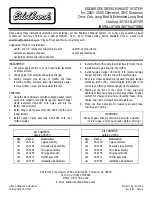
Adaptive Cruise Control
34
⇒
Continued from previous page
*1: The wheels and tires have functions that are critically important. Be sure
to use the correct ones. For details, refer to the Owner’s Manual for
your vehicle.
*2: If the brake system warning light does not turn off, immediately pull the
vehicle over in a safe place and contact a SUBARU dealer to have the
system inspected. For details, refer to the Owner’s Manual for your
vehicle.
*3: For details about the combination meter, refer to the Owner’s Manual for
your vehicle.
•
Adaptive Cruise Control is designed for use on expressways, freeways, toll
roads, interstate highways and similar limited access roads. It is not intended
to be used in city traffic. In the following conditions, do not use Adaptive
Cruise Control. Doing so may result in an accident.
- Ordinary roads (roads other than those mentioned above)
Depending on the driving environment (complexity of roads and other
factors), the system may not be able to perform as the traffic conditions
require, and that may result in an accident.
- Roads with sharp curves or winding roads
- Frozen roads, snow-covered roads or other slippery road surfaces
The tires may spin, causing loss of control of the vehicle.
- Traffic conditions when frequent acceleration and deceleration make it diffi-
cult to maintain the following distance
It may not be possible for the system to perform as the traffic conditions
require.
- Steep downhill grades
The set vehicle speed may be exceeded.
- On a steep continuous downhill grade
The brakes may overheat.
- Roads and overpasses with repeated steep uphill and downhill grades
Detection of the vehicle in front may be lost, or the road surface may be
detected instead of the vehicle in front, making correct control impossible.
- When entering a sharp curve into an interchange or junction, or a service
area, parking area, toll booth or other facilities
Detection of the vehicle in front may not be possible.
- When there are changes in brightness, such as at a tunnel entrance or exit
- When visibility is poor due to sand, smoke or water vapor blowing in the
wind, or when the front vision is obscured due to water splashes, snow, dirt
or dust stir up generated by the vehicle in front or oncoming traffic
Detection of the vehicle in front may be lost, or water or other substances
may be incorrectly detected instead, making correct control impossible.
- When there is snow, frost, dirt or dust on the windshield or it is clouded
S00652
B1302AE-A.book 34 ページ 2016年8月26日 金曜日 午後2時37分
















































